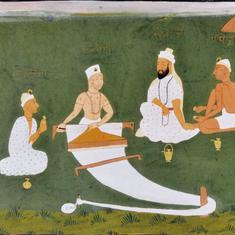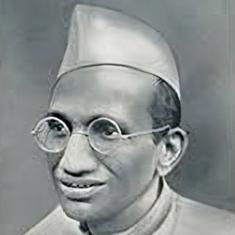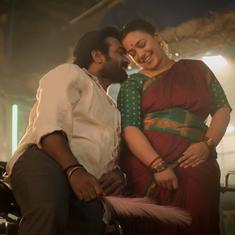Throughout the fifth Test, not many have bothered with the cricket. Even as Australia rumbled through the England batting line-up in both innings, the Oval crowd did not fail to remind everyone that this was a dead rubber – an Australian win was not going to affect the series result.
During the first four Tests, the crowd had been on the Australians’ case, with Mitchell Johnson being their favourite victim. A rebuking chant about his waywardness rang through Sophia Gardens, Edgbaston and Trent Bridge, with only the civilised hum of Lord’s providing some respite.
At the Oval, however, the England faithful almost didn’t care. So much so that all the animosity had almost disappeared. Autographs and cakes were exchanged between the crowd and the Australian outfielders. A man wearing a Spiderman suit almost convinced Mitchell Marsh, standing at fine leg, to pose for a selfie.
As Australia looked for the four remaining English wickets to win the Test on Sunday, on an almost illegible banner hanging out of the windows of one of the flats overlooking the ground were scribbled the words, “Calm down, we’ve won.”
In the Press Box, meanwhile, cricket writer and broadcaster Geoff Lemon reminded everyone that if Australia did clinch this match, they would win the 2013-15 Ashes 7-6. Fifty years down the line, if a young cricket fan were to dig down history and look at just that scoreline, she would think, wow, that must have been one helluva two-year period. How wrong would she be!
Former England captain-turned-broadcaster Michael Atherton was stating the obvious when he said on Sky Sports that the current series has not been a great one, but pointed out that the one-sided nature of the matches has been the feature of the last three series between the two sides.
One-sided wins
If you look at the 13 matches that have produced results in these last three Ashes series, only the Trent Bridge Test of 2013 (England won by 14 runs) – and the Chester-le-Street Test to some extent (England won by 74 runs) – really saw a contest between the two teams. The remaining victory margins read: 347 runs, 381 runs, 218 runs, 150 runs, eight wickets, 281 runs, 169 runs, 405 runs, an innings and 78 runs, and an innings and 46 runs.
This 2015 series was at least different from the previous two in the sense that the winner did not keep a clean sheet. But the 3-2 scoreline was hardly any reflection of the absolute refusal from either team of putting up a fight when the opposition was on top.
Former England off-spinner Graeme Swann chose to see the glass half full when he said on BBC Test Match Special that the series had seen some exceptional cricket from the home side. There is no doubting that England played extremely well in conditions that suited their seam bowlers in Cardiff, Edgbaston and Trent Bridge. At the same time, the Australians too came to the party on flat tracks at Lord’s and the Oval, where their batsmen did not have to contend with lateral movement.
There were match-winning spells from Stuart Broad (8-15), James Anderson (6-47) and Steven Finn (6-79), and magnificent centuries from Steven Smith (215 and 143), Joe Root (134 and 130) and Chris Rogers (173), but did those individual performances make it a great series to watch? Hardly. As Atherton put it, the only surprise element in the series was that England won it so “comfortably and handsomely”.
Weakening rivalry?
Atherton was also involved in an interesting discussion with Australian cricket historian and writer Gideon Haigh on Test Match Special about whether the Ashes is sport’s greatest rivalry. Haigh said that the Ashes was the “perennial benchmark” for Australian cricket. It “gives us a periodic indication of where we sit with respect to the world” and that “it doesn't matter what we do against other countries”. “We've had three series now within two years and we’re still watching it as avidly as ever,” he said.
Are we really? The 23,000-odd spectators at the Oval certainly did not think so, as they attempted forming Mexican waves even as the home team was losing. “I'm really happy England regained the urn, but I missed the excitement and the drama of the 2005 and 2009 series,” said Timothy Johnston, enjoying a celebratory pint after the game. Paul Leah was not so amused on Twitter: “An awful Ashes series, definitely one to forget.”
Do we need a five-Test series?
So, where does that leave this great sporting rivalry? If anything, there is a sense of relief that the next series between the two teams isn't until late 2017. By then, both teams would have completely different personnel, which would heighten levels of interest and intrigue.
It also raises the debate whether Test cricket really needs five-Test series. Atherton said that “a five-Test series is the greatest test of a player because bowlers get to work out batsmen time and time again.” However, recent history shows that five-Test series are only ever played between the Big Three of world cricket.
India, England and Australia are playing each other 47 times between 2013 and 2019 in either four- or five-Test series. Meanwhile, clashes such as England v New Zealand, South Africa v India, New Zealand v India and New Zealand v Australia are being recklessly clipped to two-Test blink-and-you-miss teases. If the recent two-Test England-New Zealand series is anything to go by, it is a huge injustice to the game.
It is obvious that England, Australia and India consider it financially worthwhile to play long Test series only against each other, but recent five-Test marathons between them have been quite one-sided.
The 2009 Ashes was probably the last five-match Test series that really got people to the edge of their seats. If these are trimmed down to three or maximum four-match series, the Rest would get a chance to play at least three Tests against India, England and Australia.










